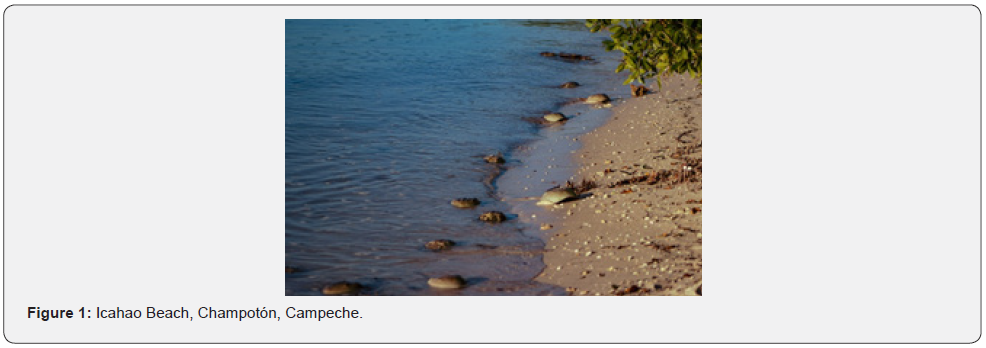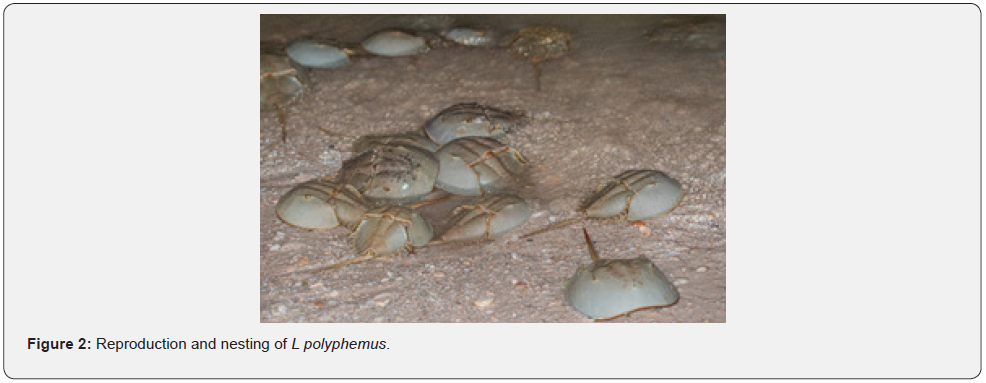Critical Habitats: Reproduction and Nesting Beaches of the Horseshoe Crab (Limulus polyphemus) in Champotón, Campeche, México
Romeo Alejandro Sánchez-Zavalegui1, Héctor Javier Ortiz-León1*, Marcela Cime-Ruíz1, Sergio Cohuo Durán1 and Carmen Olivia Rosas-Correa2
1Tecnológico Nacional de México/ I.T. de Chetumal, México
2El Colegio de la Frontera Sur-Unidad Chetumal, México
Submission:November 29, 2021; Published:February 14, 2022
*Correspondence author: Héctor Javier Ortiz-León, Tecnológico Nacional de México /I.T. de Chetumal, Av. Insurgentes 330, Chetumal, C.P. 77013, Chetumal, Quintana Roo, México
How to cite this article: Romeo A S-Z, Héctor J O-L, Marcela C-R, Sergio C D, Carmen O R-C. Critical Habitats: Reproduction and Nesting Beaches of the Horseshoe Crab (Limulus polyphemus) in Champotón, Campeche, México. Oceanogr Fish Open Access J. 2022; 14(4): 555893. DOI: 10.19080/OFOAJ.2022.14.555893
Abstract
The most important critical habitat for the conservation of Limulus polyphemus is the intertidal zone. During 2018, three beaches were sampled in the South-central Gulf of Mexico in Champotón, Campeche, to analyze the relationship between the granulometry and the beach slope with the presence of the species. The critical habitat of L. polyphemus in Champotón was characterized by coarse sand of 0.5-1mm and beach slopes between 14 to 18°. Icahao and Flamenco beaches can be considered critical habitats that must be included in national conservation programs.
Keywords: Limulus polyphemus; Critical habitat; Intertidal zone; Granulometry; Beach slope
Introduction
Limulus polyphemus inhabits specific coastal ecosystems during its life cycle, such as Rhizophora mangle forests and coastal plains in juvenile stages; bays, estuaries and coastal lakes during ambulatory stages and intertidal zones in adult stages since it carries out its reproductive cycle there [1,2]. The more frequently term used to define areas considered key to the survival of a species is “critical habitat”, and the most important are those associated to feeding and reproduction [3]. For conservation of the horseshoe crab, the intertidal zone is a critical habitat. For this species, beaches with slopes between 15° to 20°, coarse sand and tides seem to be important for reproductive aggregations and feeding [4,5].
Few studies have addressed factors related to the critical habitat of L. polyphemus, but it has been found that geochemical and erosive factors are relevant in the selection of breeding and nesting beaches [6,7]. During the 2018, the Icahao, Flamenco and Km 148 beaches were sampled to analyze the relationship between the granulometry and the beach slope with the critical habitat of L. polyphemus in the South-central Gulf of Mexico in Champotón, Campeche.
Selection of beaches was based on three criteria: 1) presence of corpses and/or exuviae, 2) differences in slope and 3) differences in sand granule size. Sand collection was done excavating 30 cm deep with a core and then 500 grams were recovered [5]. Two sand samples per site, and a total of six samples were collected. For the assessment of the granulometry Wentworth protocol modified by Román-Sierra was applied [8,9]. The sand samples were dried in the open air, and 100 g was subsampled and sieved in an automatic sieving Cole-Parmer machine for 15 minutes. We used six sieve sizes (14, 20, 30, 45, 100, 200). The beach slope was measured using a SUUNTOPM-5 manual clinometer.
Night treks were conducted at each site for 4 hours at 1-hour interval to determine the abundance of L. polyphemus in the intertidal zone. At the Icahao and Flamenco beaches 82% and 57% of the sand size, respectively, was considered coarse, both with granules size between 0.5-1 milimiters, while the Km 148 beach shows dominance of fine sand (51%), with granules size ranging 0.074-0.125 mm. The slope of the Flamenco and Icahao beaches was 18° and 16°, respectively, and at Km 148 beach was 14°. Icahao and Flamenco also show the higher abundance of L. polyphemus with 55 and 46 individuals, whereas in Km 148, 19 individuals were observed.
Relationship between size particle, slope, and L. polyphemus abundance
The size of the sand granules with the abundance of the horseshoe crab shows a strong relationship, with higher abundance in beaches with coarse sands, while flattened slopes are associated with lower number of individuals (Figure 1). Icahao and Flamenco show more suitable characteristics for reproduction and nesting and therefore are considered critical habitats subject to protection [7,10] (Figure 2). It is currently known that the horseshoe crab can detect, at a distance, the nature of the sediments for their reproduction (6). Therefore, the granulometry of the beaches plays a fundamental role in the establishment of nests, since sand granules greater than 0.5mm allow an optimal oxygen flow [6,7,11], while slopes greater than 15° prevent the substrate in the intertidal zone from becoming saturated with water, thus reducing anoxemia for optimal development of the eggs [6,7].


Conclusion
The critical habitat of the horseshoe crab in Champotón is characterized by granules size between 0.5-1mm of coarse sand and beach slopes between 16° to 18°. The grain size and slope play an important role in the reproductive cycle of L. polyphemus and their characterization allows the identification of beaches that might be critical habitats and potential sites of conservation.
References
- Gómez-Aguirre S (1993) Horseshoe crab (Limulus polyphemus L.) In the Peninsula of Yucatan. In: S I Salazar-Vallejo and N E González (eds.). Marine and coastal biodiversity of Mexico, Com Nal Biodiversity and CIQRO, Mexico, Pp. 865.
- Gómez Aguirre S, Yáñez-Martínez A (1995) Seasonal assessment of populations of Limulus polyphemus L. in the north of the Yucatán Peninsula (1994–1995). Journal of the Mexican Society of Natural History 46: 49-54.
- Gimpel PBE (2016) Defining of critical habitats for the conservation of the blue whale (Balaenoptera musculus) IN CHILE.
- Brockmann H J (1990) Mating behavior of horseshoe crabs, Limulus polyphemus. Behaviour 114(1-4): 206-220.
- Zaldívar Rae J, Sapién Silva R E, Rosales Raya M, Brockmann H J (2009) American Horseshoe Crabs, Limulus polyphemus, in Mexico: Open Possibilities. In: J T Tanacredi et al. (eds.). Biology and Conservation of Horseshoe Crabs. Springer, USA, Pp. 97-113.
- Botton ML, Loveland RE, Jacobsen TR (1988) Beach erosion and geochemical factors: influence on the spawning success of horseshoe crabs (Limulus polyphemus) in the Delaware Bay. Marine Biology 99(3): 325-332.
- Rosales Raya M (1999) Environmental characterization of Limulus polyphemus L nesting sites. Research on Isla Aguada, Isla Pájaros, Cabrera and Icahao, Campeche, Mexico (1990-1992).
- Wentworth CK (1922) A Scale Grade and Class Terms for Clastic Sediments. The Journal of Geology 30(5): 377-392.
- Román Sierra J, Navarro Pons M, Gomez Pina G, Muñoz-Pérez J J (2013) Coastal sand grain size analysis optimization. Cadiz University.
- Sandoval-Gío JJ, Zamora-Bustillos R, Avilés-Ramírez GA, Ortiz-León HJ, Rosas Correa CO (2018) First report of a spawning site of Limulus polyhemus at Ría Lagartos Biosphere Reserve, Yucatan, Mexico. BioCiencias 5: 8.
- James Pirri MJ (2012) Assessment of spawning horseshoe crabs (Limulus polyphemus) at Cape Cod National Seashore, 2008-2009. Natural Resource Technical Report NPS/CACO/NRTR2012/573. National Park Service, Fort Collins, Colorado.






























